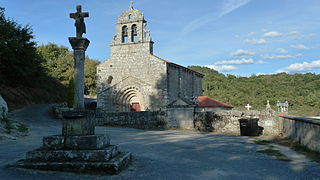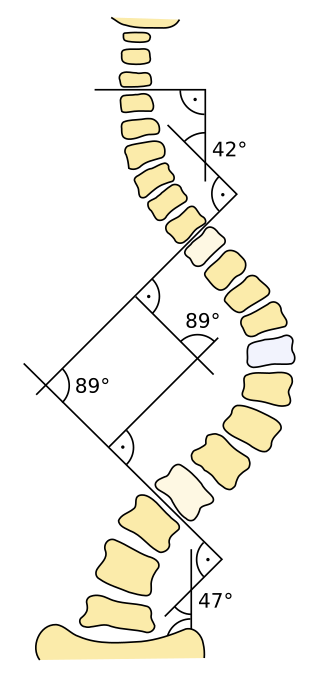Related Research Articles

Scoliosis is a condition in which a person's spine has a abnormal curve. The curve is usually "S"- or "C"-shaped over three dimensions. In some, the degree of curve is stable, while in others, it increases over time. Mild scoliosis does not typically cause problems, but more severe cases can affect breathing and movement. Pain is usually present in adults, and can worsen with age. As the condition progresses, it may impact a person's life and hence, can also be considered a disability.

Kyphosis is an abnormally excessive convex curvature of the spine as it occurs in the thoracic and sacral regions. Abnormal inward concave lordotic curving of the cervical and lumbar regions of the spine is called lordosis. It can result from degenerative disc disease; developmental abnormalities, most commonly Scheuermann's disease; Copenhagen disease, osteoporosis with compression fractures of the vertebra; multiple myeloma; or trauma. A normal thoracic spine extends from the 1st thoracic to the 12th thoracic vertebra and should have a slight kyphotic angle, ranging from 20° to 45°. When the "roundness" of the upper spine increases past 45° it is called kyphosis or "hyperkyphosis". Scheuermann's kyphosis is the most classic form of hyperkyphosis and is the result of wedged vertebrae that develop during adolescence. The cause is not currently known and the condition appears to be multifactorial and is seen more frequently in males than females.

Fibrous dysplasia is a disorder where normal bone and marrow is replaced with fibrous tissue, resulting in formation of bone that is weak and prone to expansion. As a result, most complications result from fracture, deformity, functional impairment, and pain. Disease occurs along a broad clinical spectrum ranging from asymptomatic, incidental lesions, to severe disabling disease. Disease can affect one bone (monostotic), multiple (polyostotic), or all bones (panostotic) and may occur in isolation or in combination with café au lait skin macules and hyperfunctioning endocrinopathies, termed McCune–Albright syndrome. More rarely, fibrous dysplasia may be associated with intramuscular myxomas, termed Mazabraud's syndrome. Fibrous dysplasia is very rare, and there is no known cure. Fibrous dysplasia is not a form of cancer.

A back brace is a device designed to limit the motion of the spine in cases of bone fracture or in post-operative spinal fusiona, as well as a preventative measure against some progressive conditions or to correct patient posture.

Taboada, is a municipality in the Spanish province of Lugo.

Scheuermann's disease is a self-limiting skeletal disorder of childhood. Scheuermann's disease describes a condition where the vertebrae grow unevenly with respect to the sagittal plane; that is, the posterior angle is often greater than the anterior. This uneven growth results in the signature "wedging" shape of the vertebrae, causing kyphosis. It is named after Danish surgeon Holger Scheuermann.

Pheneturide, also known as phenylethylacetylurea, is an anticonvulsant of the ureide class. Conceptually, it can be formed in the body as a metabolic degradation product from phenobarbital. It is considered to be obsolete and is now seldom used. It is marketed in Europe, including in Poland, Spain and the United Kingdom. Pheneturide has a similar profile of anticonvulsant activity and toxicity relative to phenacemide. As such, it is only used in cases of severe epilepsy when other, less-toxic drugs have failed. Pheneturide inhibits the metabolism and thus increases the levels of other anticonvulsants, such as phenytoin.

G protein-coupled receptor 126 also known as VIGR and DREG is a protein encoded by the ADGRG6 gene. GPR126 is a member of the adhesion GPCR family. Adhesion GPCRs are characterized by an extended extracellular region often possessing N-terminal protein modules that is linked to a TM7 region via a domain known as the GPCR-Autoproteolysis INducing (GAIN) domain.
Chiropractors use their version of spinal manipulation as their primary treatment method, with non-chiropractic use of spinal manipulation gaining more study and attention in mainstream medicine in the 1980s. There is no evidence that chiropractic spinal adjustments are effective for any medical condition, with the possible exception of treatment for lower back pain. The safety of manipulation, particularly on the cervical spine has been debated. Adverse results, including strokes and deaths, are rare.

Matrilin 1, cartilage matrix protein, also known as MATN1, is a matrilin protein which in humans is encoded by the MATN1 gene.

The Cobb angle is a measurement of bending disorders of the vertebral column such as scoliosis and traumatic deformities.
Axial Biotech, Inc. was a privately held molecular diagnostics company based in Salt Lake City, Utah. It was founded in 2002.
Dewey Lake State Forest is a state forest in Floyd County, Kentucky, United States. The 7,353-acre (29.76 km2) forest is leased to the state of Kentucky by the United States Army Corps of Engineers. The forest is in proximity of Jenny Wiley State Resort Park.

The neuromechanics of idiopathic scoliosis is about the changes in the bones, muscles and joints in cases of spinal deformity consisting of a lateral curvature scoliosis and a rotation of the vertebrae within the curve, that is not explained by either congenital vertebral abnormalities, or neuromuscular disorders such as muscular dystrophy. The idiopathic scoliosis accounts for 80–90% of scoliosis cases. Its pathogenesis is unknown. However, changes in the vestibular system, a lateral shift of the hand representation and abnormal variability of erector spinae motor map location in the motor cortex may be involved in this disease. A short spinal cord and associated nerve tensions has been proposed as a cause and model for idiopathic scoliosis. Besides idiopathic scoliosis being more frequent in certain families, it is suspected to be transmitted via autosomal dominant inheritance. Estrogens could also play a crucial part in the progression of idiopathic scoliosis through their roles in bone formation, growth, maturation and turnover. Finally, collagen, intervertebral disc and muscle abnormalities have been suggested as the cause in idiopathic scoliosis, although these are perhaps results rather than causes.

(HES7) or bHLHb37 is protein coding mammalian gene found on chromosome 17 in humans. HES7 is a member of the Hairy and Enhancer of Split families of Basic helix-loop-helix proteins. The gene product is a transcription factor and is expressed cyclically in the presomitic mesoderm as part of the Notch signalling pathway. HES7 is involved in the segmentation of somites from the presomitic mesoderm in vertebrates. The HES7 gene is self-regulated by a negative feedback loop in which the gene product can bind to its own promoter. This causes the gene to be expressed in an oscillatory manner. The HES7 protein also represses expression of Lunatic Fringe (LFNG) thereby both directly and indirectly regulating the Notch signalling pathway. Mutations in HES7 can result in deformities of the spine, ribs and heart. Spondylocostal dysostosis is a common disease caused by mutations in the HES7 gene. The inheritance pattern of Spondylocostal dysostosis is autosomal recessive.
Hilda Akua Frimpong is a Ghanaian model and beauty pageant titleholder who was crowned Miss Universe Ghana in 2015 and represented Ghana at the Miss Universe 2015 pageant. After being diagnosed with scoliosis in 2012, Frimpong became a health activist and advocate on prevention and treatment of the condition. In 2021 whilst studying at the Syracuse University College of Law, she was named as the new editor-in-chief of the Syracuse Law Review, making her the first Black person to occupy the position.
The management of scoliosis is complex and is determined primarily by the type of scoliosis encountered: syndromic, congenital, neuromuscular, or idiopathic. Treatment options for idiopathic scoliosis are determined in part by the severity of the curvature and skeletal maturity, which together help predict the likelihood of progression. Non-surgical treatment should be pro-active with intervention performed early as "Best results were obtained in 10-25 degrees scoliosis which is a good indication to start therapy before more structural changes within the spine establish." Treatment options have historically been categorized under the following types:
- Observation
- Bracing
- Specialized physical therapy
- Surgery
Katharina Schroth was a German physiotherapist best known for developing the Schroth Method for Scoliosis. She was born in Dresden with scoliosis, and after years of wearing a thoracic brace to treat it, Schroth set out to find other treatment options. She used breathing techniques, pulley systems, and stretching. These techniques became the basis for the Schroth method and were shared among physiotherapy institutions to treat other patients. The first institution, Breathing Orthopedics, opened in 1921 in Meissen. The second institute was in Sobernheim. The Schroth method introduced a new path of treatment and set the precedent for how other related techniques were developed. For this work, Schroth was awarded the Federal Cross of Merit by the Federal Republic of Germany. Her two institutes were passed down to her daughter, Christa Lehnert-Schroth, and later to her grandson, Dr. Hans-Rudolf Weiss, MD. Dr. Weiss now has his practice where he uses modified versions of his grandmother’s techniques to help those with scoliosis today.

Adolescent idiopathic scoliosis is a rather common disorder in which the spine starts abnormally curving sideways (scoliosis) at the age of 10–18 years old. This disorder generally occurs during the growth spurt that happens right before and during adolescence. In some teens, the curvature is progressive, meaning that it gets worse over time, however this is rare, since it is more common for this variant of scoliosis to show itself as a mild curvature.
Pierre Stagnara was a French spinal surgeon. He has been described as a "pioneer" in the study of spinal deformities, "one of the greatest figures of French spinal surgery," and the "father of spine surgery in France." Stagnara was born in January 16, 1917 in Loriol-sur-Drôme, France. He studied medicine in the city of Lyon. During World War II he was drafted into the French army. After the war, he worked in a variety of hospitals throughout Lyon. In 1959 he became the Chief of the Centre des Massues and served in this position until his retirement in 1982. Whilst working at the institution he pioneered many orthopedic techniques. Including the non-surgical management of scoliosis.
References
- ↑ "National Scoliosis Foundation". Archived from the original on 2014-11-21. Retrieved 2014-12-17.
- ↑ Izatt, Maree T; Bateman, Gary R; Adam, Clayton J (2012). "Evaluation of the iPhone with an acrylic sleeve versus the Scoliometer for rib hump measurement in scoliosis". Scoliosis. 7 (14): 14. doi: 10.1186/1748-7161-7-14 . ISSN 1748-7161. PMC 3479427 . PMID 22846346.